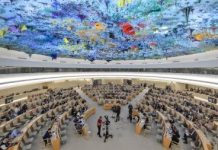DNA
LAHORE: (Feb 04) The Pakistan Industrial and Traders Associations Front (PIAF) on Saturday said that massive fall of rupee value continued to damage the economy, as the local currency has hit a new all-time low at Rs276 mark against US dollar in the interbank market amidst uncertainty regarding the outcome of the ongoing talks between Pakistan and the International Monetary Fund, devaluing cumulatively by almost 17% or Rs45 during the last week.
PIAF Chairman Faheem ur Rehman Saigol said that there was a complete breakdown of economic policymaking, as the country’s fiscal policy had become subservient to monetary and exchange rate policies. He argued that this devaluation of the currency was dictated by the IMF through prior actions, as uncertainty regarding the timing of inflows of foreign currency has continued to impact the rupee-dollar exchange rate.
He said that the monetary tightening and exchange rate depreciation resulted in higher inflation, public debt and debt servicing. The empirical evidence showed that the one percent monetary tightening hiked the inflationary pressure by 1.3 percent in the case of Pakistan, he added.
PIAF Chairman observed that besides increasing exports the government will have to take administrative measures, as a large demand of cash dollars are seen in the market. He said that the IMF has continued to remain tough with Pakistan in the ongoing talks to ensure its prerequisite conditions are implemented. The lender has demanded political consensus on the resumption of the loan program and has also rejected the government’s circular debt plan.
No relaxation in the IMF’s conditions has been made despite the government’s repeated request. This continues to destabilize financial markets leading to economic uncertainty. The government has, however, assured the global lending institution that it shall implement all of its conditions. He explained that the demand for US dollars has remained high in the system due to the piled up imported raw material lying at Karachi ports. The currency is market determined. Accordingly, the rupee-dollar exchange rate depreciates on the days when demand for the foreign currency appears higher than supplies in the market, he added.
As per the State Bank of Pakistan, the currency settled at 276.58, a decline of Rs5.22 or 1.89% against the US dollar. The currency has depreciated by 25.93% during the ongoing fiscal year against the greenback. In the open market, the rupee lost 6.50 rupees for buying and 7.50 rupees for selling against USD, closing at 280 and 283, respectively. Friday’s closing was the weakest level for the rupee, and comes as talks between the IMF and Pakistan continued in Islamabad. Moreover, our forex reserves continue to deplete at a quick rate, which is also taking its toll, he said. Market expects inflation to climb above 30% in recent months. The commitments made by the Finance Minister and SBP Governor on inflows are yet to be materialized, creating a perception that the authorities cannot do much to curb the ongoing deterioration, he added. Meanwhile, foreign exchange reserves held by the State Bank of Pakistan dropped a massive $592 million to a mere $3.09 billion, data released on Thursday showed. This is the lowest level of central bank reserves since February 2014.
He urged the government to control volatility of rupee against the US dollar, as the industrial revival and economic growth is not possible without stability of local currency. He said that the massive devaluation of currency fuelled inflationary pressures, adding that two major factors contributed to the price hike.












